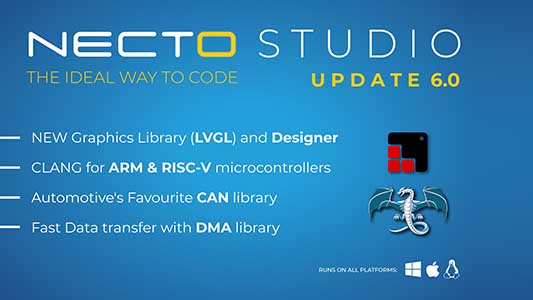MikroElektronika (MIKROE) has unveiled v6.0 of NECTO Studio, the company’s complete, cross-platform integrated development environment (IDE) for embedded applications. The latest version has six new major features including: an enhanced graphics library with a brand new UI designer; CLANG & LLVM toolchains for ARM and RISC-V microcontrollers; CAN support; integrated DMA control; and RTC and LCD available in the mikroSDK.
Comments Nebojsa Matic, CEO of MIKROE: “The latest update to NECTO Studio IDE significantly improves the development experience. Inclusion of LVGL enhances the graphical aspects of projects. Clang for ARM and RISC-V compilers integration, along with LLDB for ARM and RISC-V debuggers, provides powerful tools for code compilation and debugging. The IDE now boasts advanced debugging features, such as call stack support for GCC and Clang compilers, a detailed core registers view, and a comprehensive library collection for CAN, DMA, RTC, and LCD within the mikroSDK framework, streamlining the development process.”
The LVGL enhanced graphics library with new UI designer enables users to bring circuits to life with a blend of algorithmic precision and graphical creativity. Featuring intuitive drag-and-drop functionality, this IDE update enables developers to craft visually appealing and user-friendly interfaces. The ability to group and save custom controls enhances workflow efficiency and project consistency. Multi-screen design support facilitates the creation of complex, versatile applications that seamlessly adapt to various devices.
NECTO Studio takes a significant leap forward in improving the coding experience on multiple platforms by integrating the Clang compiler for ARM and RISC-V architectures. With features like comprehensive call stack analysis and a detailed core registers view, debugging becomes more intuitive and efficient, expediting problem identification and resolution in complex projects.
The two-wire CAN interface now included within NECTO Studio’s mikroSDK library ensures real-time communication between components, optimizing performance in applications ranging from automotive controls to industrial automation. And the DMA controller, also integrated within the mikroSDK library, enhances system performance, reduces CPU load, and optimizes data transfer, collectively improving device responsiveness and operation.
Other improvements include better debugging and support for more boards.
Concludes Matic: “NECTO Studio 6.0 provides everything necessary to start developing, and prototyping, including Click board applications and GUIs for embedded devices. Rapid software development is easily achieved as developers do not need to consider low-level code, freeing them up to focus on the application code itself. This means that changing the MCU or even the whole platform will not require developers to redevelop their code for the new MCU or platform. They can simply switch to the desired platform, apply the correct board definition file, and the application code will continue to run after a single compiling operation.”












